Feature by
Dalia Miller
Photographs by Kip Miller
It’s a June morning shrouded in mist. Our group of five has just
boarded the Skopelitis Express bound for Amorgós, the wildest island
of the Cyclades, rising like a giant snake on the eastern edge of the
archipelago. Even though it’s our 27th trip to Greece, my husband
and I have never explored this part of the Aegean and we are filled with
the same intense excitement that marked our very first time in 1969.
During that
year, while we were just discovering Athens and the Argolid Peninsula,
unpaved Amorgós served as a place of exile for the ruling military
Junta. Isolated from its neighboring islands, it was ideally suited for
political outcasts but much too primitive for most visitors. Decades later,
this rugged outpost has transformed itself into a model of green living
and alternative tourism. It also remains one of a handful of Aegean islands
where traditional life has hardly changed.
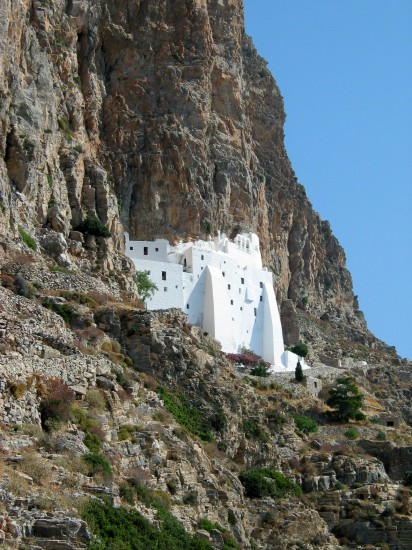
The monastery of Pangaía Hozoviótissa, seemingly suspended on the cliff of Profitis Ilias
Until Claude Besson’s underwater film, “The Deep Blue,”
came out in 1988, most tourists had never even heard of Amorgós.
But Greeks have been visiting the island for centuries. They come to express
their devotion at the dramatically sited Panagía Hozoviótissa
Monastery, dazzling white and clinging to a sheer cliff overlooking the
Agía Anna beach. Many believe it was built by divine intervention.
According to local legend, during the iconoclastic wars in the 11th century,
a woman from Hozóvo in Asia Minor rescued an icon of the Virgin
Mary and ran to the sea with it, placed it on a wooden boat, lit a candle,
and pushed it into the waves. The icon reached the southeastern shore
of Amorgós and the event was deemed miraculous. The Amorgianoí
began building a monastery to house the icon on an easily accessible plot
of land, but every morning they found their previous day’s work totally
undone. One day even their tools were missing. They searched everywhere
and found them hanging from a large iron stake driven into the mountain
300 meters above the sea. This was taken as a sign from God and the monastery
was built on the steep site under the auspices of Byzantine Emperor Alexios
Komninos.
Only two monks still live and work in Hozoviótissa today. Nonetheless, they extend hospitality to thousands of visitors each year and tend a collection of sacred manuscripts and relics without electricity and modern conveniences.
From the
sea, steep-sided Amorgós seems unapproachable, battered by sudden
gusty winds that can make you lose your balance. The winds keep it cool
in summer and visitors throng. Even the ancient Minoans came here to escape
sweltering heat waves in Crete. In earlier years the island was densely
covered with oaks and junipers, but a massive fire in 1835 left only clusters
of trees hidden in the chasms of its highest peak, Mount Kríkellos.
Nature has its way, however, and where trees once ruled more than 600
species of herbs and shrubs now thrive. In spring and early summer hikers
are rewarded with heady fragrances of sage, rosemary, thyme and oregano,
and vibrant fields of vermilion poppies, wild hyacinths and daisies.
Sleepy Aegiáli boasts the best beach on Amorgós.
All at once, the winds die down and our ferry glides into Aegiáli, the northern port on a sandy beach fringed with tamarisks. Above the bay, whitewashed villages gleam like jewels on mountain crags. We check in at the rambling, family-run Lakki Village operated by the Gavalas family on the grounds of a large orchard with a restaurant right at the water’s edge. “Here, you can eat and swim and at same the time,” they tell us with a smile.
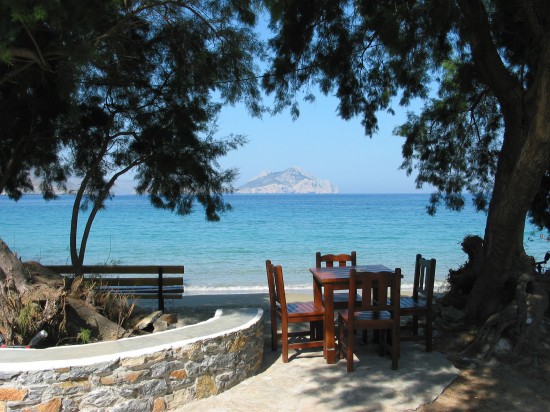
Lakki Village: Where “you can eat and swim at the same time.”
One of our friends, Maria, is a noted ethnologist who visited Amorgós
thirty years ago to record its folk songs and document island dances.
“Is it still possible to experience traditional music and dance today?”
we ask around. Our inquiry at a souvenir shop near the harbor hits a gold
mine.
“Come
to Nikos Taverna in Langáda tomorrow,” says Yiorgos Vassalos,
the proprietor, after a couple of quick telephone calls. “It’s
my brother’s restaurant and we are going to have a special party
in your honor with musicians and many of our family who will dance.”
Apparently, a violinist who is a frequent guest musician at the taverna,
fondly remembers the recording sessions that had taken place so long ago.
Yiorgos encourages us to explore the island, making several valuable suggestions,
and to rendezvous at eight. Ti oraía, efharistoúme pára
polí (“how lovely, thank you very much”), we respond,
overcome by such spontaneous generosity.
Dilapidated windmills and an old threshing floor frame whitewashed Hora.
All five of us pack into a rental car and wind our way to Hora, the island capital, tucked into a fold in the central mountains, well hidden from the ports that were continuously attacked by pirates in centuries past. Several dilapidated windmills perch on the mountain ridge like worn out props on a vast outdoor stage and, soon, the remnants of Hora’s kástro (castle) on a rocky outcrop come into view. The town itself is a maze of blinding white houses with blue shutters, some 40 churches, arched passageways, narrow cobblestone lanes, hot pink bougainvillea and cats sleeping on window sills. In a tiny confectionery, well-practiced hands are making pastéli, the sesame candy that is popular throughout Greece. On another lane, a small shop displays shadow puppets for sale. We stop at Agíos Fanários, the smallest church in all of Greece with only enough room for three people to stand.
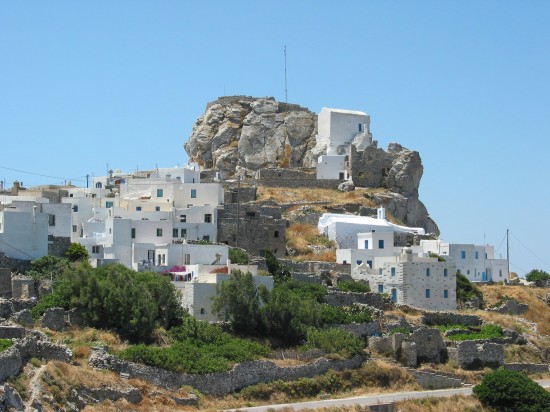
Hora’s Venetian kástro, built into a limestone outcrop above the town.
Most of the alleyways lead to Loza, the sloping central square where today a noisy wedding reception is underway. Nearby, Lila Marangou, the island’s chief historian, runs the archaeological museum housed in an elegant 18th century arhóntiko (mansion). Rooms are jam-packed with treasures gathered from a handful of ancient settlements. She tells us that Amorgós has several active digs where outstanding Cycladic sculptures have been unearthed: a one-meter-high goddess, the largest ever found in the Aegean, is now proudly on display at the National Archaeological Museum in Athens.
Hora’s housewives are busy cooking their mid-day meal and we are seduced by delectable aromas wafting from curtained doorways. At Liotrívi, a shady rooftop restaurant with a commanding view of the town, cold beers come to our table accompanied by (fáva), the tangy island dip, and stuffed tomatoes delicately seasoned with herbs and currants. We appreciate the subtlety of the cooking. The waiter flashes a proud smile, boasting that Amorgós is entirely self-sustaining and does not need to import any food products. “Too bad you aren’t here at Easter,” he exclaims. “That’s when we serve patatáto, our delicious stew of goat and potatoes in a special sauce with herbs!”
Hozoviótissa’s tiny medieval entrance
The road from Hora loops to the sea. Suddenly, whitewashed Hozoviótissa glints in the sun, suspended in the orange-hued rock face of Profitis Ilias. We park at the bottom of the mountain and begin a serpentine ascent up 300 steps to the monastery. The views are breathtaking in every direction and we stop now and then to catch our breath and gaze at the clearest waters in the entire Aegean. The transparency of the water and the fine white sand underneath were the very reason Besson decided to film here. Dug into the middle of the mountain, Hozoviótissa is about eight or nine stories high and five meters thick. We enter from the courtyard and climb flights of stairs to the reception room, church and library. Incense perfumes the air. Hand-written manuscripts, centuries-old paintings and the treasured icon of the Panagía (Virgin Mary) framed in silver are prominently on display. Father Spyridon welcomes each of us with a little glass of rakómelo, the local spirit laced with honey, chased by cool spring water and a loukoúmi, a delightful confection. He smiles and tells us that Hozoviótissa’s special feast day is celebrated on November 21, and that at Easter its treasured icon travels in a ceremonial procession on ancient footpaths to the island’s many churches. We catch another glimpse of the Aegean beyond. The vistas from mismatched windows of the façade are all thrilling, but the view from the topmost balcony is one we will never forget. Agía Anna, the secluded turquoise beach beyond is the very embodiment of paradise. Stretched out on large rocks not far from the water are two nude figures basking in the sun, totally unaware that they can be viewed from a holy place above!
The serene bay of Aegiái viewed from the heights of Tholária
The evening breeze is gusting in Aegiáli and the air has turned
deliciously cool. We stroll around the charming harbor area and watch
the sun sink into the sea. Local fishermen are noisily playing távli
(backgammon) in seaside bars, hurling insults at each other as they play
to win, back-slapping and clinking glasses of rakí. On a quiet
side street, we gather under a spreading laurel at Kyra Katinas and sample
kalamária and kakávia (fish stew). The restaurant is alive
with animated conversations. We make a toast to this little gem of an
island.
All of us
rise early on Saturday in anticipation of a music-filled evening. “Traditional
celebrations are still very much a part of island life,” says Nikki
Gavala as she brings us our breakfast yogurt and honey. “In Langada
they have a winter Carnival ritual, O Kapetánios,” she explains
in very good English. “A young man dressed up as the groom arrives
on horseback accompanied by musicians. After the horse runs back and forth
a few times, he selects a bride and a wedding ceremony takes place, followed
by loud singing and dancing until morning.”
About 1,800 people live on Amorgós, several hundred of them in
the mountain villages of Tholária, Langáda and Potamós.
Since our rendezvous is at night, we decide to explore Langáda
by daylight. On the town’s widest cobbled street, a donkey laden
with bags of vegetables is making a delivery to Nikos Taverna, the social
hub of the village, with a rambling, leafy terrace crowded with tables
and chairs. Next door, Kyra Irini runs the wood-burning artopoeíon
(bakery), supplying the restaurant and the entire town with its distinctive
dark brown bread. Both are part of a traditional hotel complex, Pangáli,
and a small organic farm that are operated by Nikos and his wife, Ioanna.
Pungent scents emanate from an attractive shop brimming with bundled herbs, soaps and lotions. “Come in and have a sniff,” beckons Vangelis Vassalos (a family member, we are sure). He and his wife Eleni are the island’s leading herbalists. After studying neurophysiology and Chinese medicine in England, Vangelis recently returned Langáda to develop a business based on the cultivation of local plants. “Amorgós has a lot of surface area for herbs to thrive,” he explains. “We grow many different species, some rare and unusual, like wild fennel, verbena and many varieties of mint and marigolds plus all the usual culinary herbs.” They also distill essential oils for cosmetics, give aromatherapy and acupuncture sessions, and export a variety of products to many countries. He is proud that his shop has had good support from the EU which is helping to market Amorgós as a wellness destination. Another villager, Panayiotis Maroulis, manages an organic honey farm with hives on the neighboring islet of Nikouriá. We sample his signature honey, “Amorgianó,” a prizewinner at international competitions. The sweetness lingers on our lips as dried honey crystals release encores of pleasure.
Above Langáda, near the heights of Mount Kríkellos, Stroúmbos is a tiny enclave of 12 houses and 13 ovens built on steep rocks above a ravine. Some of the houses are currently being restored by summer visitors. And no wonder. The view here is a front balcony seat over the entire glistening bay of Aegiáli, the villages and tiny Nikouriá where coins were once minted for the ancient cities of Amorgós. Discerning eyes can even locate the island of Ikaría in the eastern Aegean.
Goat bells tinkle and donkeys bray somewhere in a distant meadow as we climb to Tholária. Built high above the bay of Aegiáli, the village reigns over the olive groves of Vigla, where the ancients built their acropolis and worshipped Asclepius, the god of medicine. Shops seem to outnumber houses as we stroll through medieval vaulted streets to a large cathedral, the pride and joy of the town. At a crowded café, Horeftís, patrons are poring over newspapers as they sip frappedákia (iced coffee). We stop at the terraced Aegiális Hotel, the brain child of Irini and Nikitas Giannakopoulos and undoubtedly the finest hotel in Amorgós. Here, guests can experience spa treatments, nature walks and meals based on a large organic garden, or spend hours basking by a luxurious sea water pool. On the terrace, our ouzos are accompanied by favókeftedes (fava croquettes), herbed olives and chunks of honeyed goat cheese.
In the upper
part of Potamós, a tiny village with a huddle of whitewashed houses,
an old crone sits on her stoop trimming green beans over a large basket.
Behind her open doorway we spot an ancient stove with a simmering pot
of something that smells incredibly delicious. A few doors away, several
old men are drinking coffee, laughing and reminiscing about the old days
when so many of them were avid sailors. Little has changed here for centuries.
Oh, what we would give for a hammock now to loll away the afternoon under
the shade of three huge fig trees framing the view of the bay!
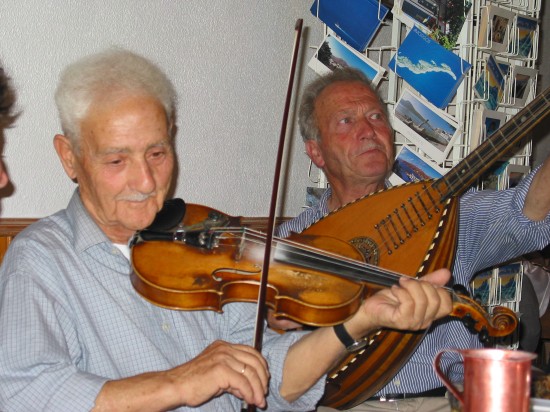
Stefanaki on violin and Michalis on laoúto at Nikos Taverna, Langada
By the time we arrive at Nikos at eight the tables are nearly filled with the extended Vassalos family, including Yiorgos, his wife, children and assorted friends. Two musicians, Michalis on laoúto (lute) and Stefanakis on violí (violin), are playing Amorgianoí island melodies with gusto. Everyone hovers around our Maria, who recognizes a few old faces and gets a little emotional. Nikos and Ioanna bring out a huge assortment of appetizers and all the specialties of the house: zucchini and tomato fritters, eggplant dip, tiny skewers of grilled lamb, salads from the organic garden, their version of patatáto, and rooster braised in wine prepared from a secret village recipe. Clinking glasses every few minutes, dozens of toasts are made around our long table. Several men begin to dance, starting out with an island syrtó (a traditional line dance), followed by ni-ke-dre, danced in a shoulder hold, and then a soústa, a faster dance with syncopated small steps. Our table empties as the dance floor fills. The musicians are versatile and move on to music from neighboring Naxos and Paros as well as popular modern songs. It is a joyous occasion and almost everyone takes a turn on the dance floor: grandparents, children, even latecomers who wander in to see what the fuss is all about. Maria is in her element and bursts into song with the entire paréa (group). For our final toast, Nikos uncorks a bottle of psiméni rakí, a strong spirit they make right on the premises. The immense pride and filoxenía (hospitality) of the Vassalos family are astonishing. We hug; we kiss. We say thank you two dozen times, promising to stay in touch. Back in Aegiáli, roosters begin to crow, donkeys hee- haw, and the scent of sage wafts down from the hills through our open windows, but we remain glued to our beds until mid morning.
Maria is in her element on the dance floor.
Katápola is considered the finest natural harbor in the Aegean with a large jetty that welcomes hydrofoils, assorted ferries and yachts. We wind our way toward the bustling port area, a former bastion of pirates from many lands. A southerly afternoon breeze caresses us as we take in the scene. Sunbathers are stretched out on the central beach while noisy fishmongers hawk their catch near the pier. Scavenging cats are fighting over assorted scraps just tossed out of a taverna kitchen where two cooks are frying heaps of marídes (whitebait). Fishing nets are spread out to dry and to mend. Enticing back streets are lined with tiny souvenir shops and flowers. We spot a café bar called “The Big Blue,” where the film that brought so many French tourists to Amorgós is shown nightly. At the end of the harbor Minos Taverna is packed with exuberant locals, their tables laden with beer bottles and platefuls of grilled octopus and fried gávros (anchovies). A large ferry unloading passengers from Santorini is besieged by women waving signs for many of Katápola’s small pensions. Seasoned shoppers are squeezing tomatoes and fruits at a well-stocked grocer who is offering free tastes to close the sale. Running to the beach, several British tourists erupt in gales of laughter as they share their latest Greek island misadventure. We soak up the atmosphere like Aegean sponges, then head for the silence of the hills.
Katápola, the finest harbor in the Aegean
Above the town lie the ruins of ancient Minoa where a sizable acropolis is under excavation. Sitting on a large rock by the entrance, a wizened shepherd offers to share his cache of bread and olives with us. We ask for directions. He waves his index finger toward Kato Meriá where fertile meadows grow most of the island’s crops. “In the old days flax was cultivated here whose flower gave Amorgós its name,” he says. In Arkessíni we find the best preserved archaeological remains on the island, a massive square tower (pyrgos), with walls from both the classical and Hellenistic periods. At the island’s southern tip, a large stone Cycladic figure playing a harp has been left in situ on the edge of a rugged cliff, a muse to the lucid sea beyond.
Picture postcard Cycladic: a side street in Katápola
On our last night in Amorgós and we gather at Panórama,
a popular grill in Tholária recommended for its music. Nikolaos
Theologitis, the owner, is belting out mantinádes (rhyming couplets)
which he makes up on the spot to suit the occasion and the audience. His
creativity and stamina are remarkable. Full of energy well beyond his
years, he whirls non-stop on the dance floor while younger dancers fade.
We wander
outside to view the harbor lights and reflect. The couplets evoke a beautiful
poem entitled Amorgós, written by Nikos Gatsos, Greece’s brilliant
songwriter. Considered a masterpiece of 20th century Greek poetry, it
blends folk tradition with surrealism. I am amazed that Gatsos never actually
ever saw the island that he wrote so eloquently about during the brutal
Nazi occupation. Perhaps he was inspired by the frequent caïques
from Amorgós that penetrated the German blockade, delivering lifesaving
supplies of olive oil to hungry Athenians. Reading even a little snippet
of his long poem is like drinking ice water on a hot day: so refreshing,
it makes you gasp. Amorgós has been like that for all of us, refreshing,
authentic, with a spirit of hospitality beyond all our expectations.
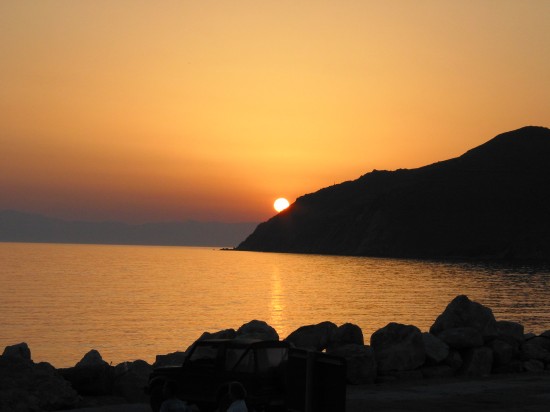
The sun sinks behind the mountains in Aegiáli.
The music inside has changed tempo. Nikos switches to a popular old folk song:
“Oh
that I was a bird, a bird with golden wings
To fly to Amorgós, for only a moment to sing….”
As we get up to leave, I make up my own mantináda:
“An
eagle hears a siren’s song as he flies to his aerie.
To scented Amorgós he will return… and one day so shall we.”
